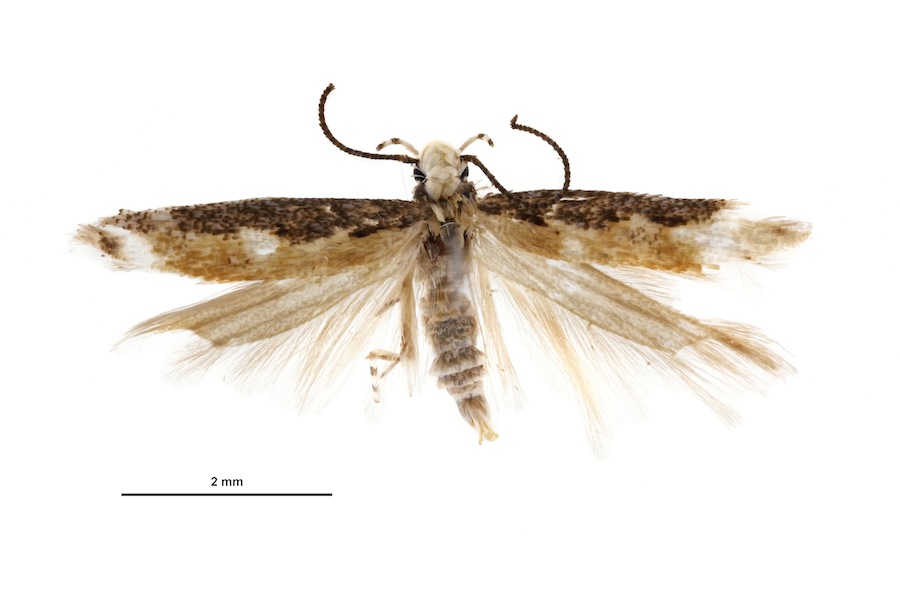
New moth species named Neopalpa donaldtrumpi, raises awareness for environmental conservation
Microscopic combovers and barren sand dunes have gifted the world with a new moth species named after a man with the country’s most infamous hairstyle. The Neopalpa donaldtrumpi moth was collected by a team from the Bohart Museum of Entomology at UC Davis.
The Neopalpa donaldtrumpi, named a couple of days before the inauguration of President Donald Trump, is a moth with a 7-17mm wingspan and light yellow scales on its head, according to the journal article that first described it. Some say that the moth bears a resemblance to its namesake: Donald Trump. Regardless of the moth’s physical appearance, its name brings attention to conservation issues around the Algodones Dunes, where the moth was found, and to habitat preservation in general.
Lynn Kimsey, the director of the Bohart Museum of Entomology and a professor of entomology at UC Davis, led the expedition to the Algodones Dunes, which is a desert landscape located just north of the California-Mexico border.
“[The expedition] was a contract with the Bureau of Land Management to do a complete insect survey of the dunes,” Kimsey said. “We collected several hundred thousand specimens down in the dunes and we have various specialists look at them to identify species.”
It was one of those specialists, Vazrick Nazari, who identified and named the moth. As to why Nazari named the moth N. donaldtrumpi, Kimsey suspects that the name stems from a variety of reasons and not just because of the yellow scales on the top of the moth’s head.
“I think his idea was to name it after someone visible […] to make a point about the importance of these habitats,” Kimsey said. “The average person thinks of deserts as just wastelands.”
In fact, according to Kimsey, the Algodones Dunes in particular are especially rich in insect species, which makes conservation all the more important.
“The Algodones Dunes are about 200 square miles of sand,” Kimsey said. “There are a few plants scattered around, but it’s mostly just sand. We got almost 2,000 different kinds of insects on those dunes and six percent of them were new to science, which is a fairly big number.”
In addition to being a hotbed of insect diversity, the Algodones Dunes are a traditionally hostile environment, which means that its inhabitants often have interesting biological adaptations.
“One of the things that we had discovered was that the insects that survive in desert situations often times have very special adaptations, both physiological and biochemically,” Kimsey said. “Some of those chemicals actually turn out to be incredibly useful in terms of pharmaceuticals or industrial compounds.”
According to Kimsey, some insects don’t just survive in the extreme desert heat, they thrive in it.
“Quite a number of insect are only active during the summer when it’s hottest […] Sand temperatures in the dunes around June or July average around 160 to 170 degrees,” Kimsey said. “Insects are cold blooded, so they are whatever temperature they’re surrounded by. That means they’re tolerating temperatures that, except for bacteria, almost nothing else can tolerate, which means they must have some awesome heat shock proteins or other chemical adaptations that allow them to function at those temperatures.”
One of Kimsey’s colleagues, Steve Heydon, a senior museum scientist at the Bohart Museum of Entomology, helped collect this specimen and describes the specimen as an “LBM,” or little brown moth. According to Heydon, with its wings spread it still only measures about 1 to 1.5 centimeters.
“If you put [the moth] under the microscope it really does have those little scales on the top of the head that kind of flip up,” Heydon said.
The scales Heydon refers to are the microscopic feature that relate the Neopalpa donaldtrumpi to its name.
This moth was collected using a Malaise trap which Heyden defined as a tool primarily used to collect bees, wasps, flies and other insects, but is also capable of collecting certain moths. The trap allowed those on the expedition to acquire an insect so small and delicate in a terrain where a “little brown moth” would be able to easily blend in. For a visualization, Heydon equates the trap to a “modified tent.”
While both Heydon and Kimsey helped physically discover this moth, there is a entire separate process to researching and learning about a new species once it is found for the first time. According to Heydon, unless someone specifically chooses to research this new species of moth it could be “centuries” before it is fully understood.
“When it comes to insects there is almost no information for most of the species,” Heydon said.
Marc Epstein, a senior insect biosystematist, explained how the conservation of the dunes served as the foundation of the whole expedition.
“The case for conservation of the Algodones and other unique environments is always best when the case is made about the unique biota, the numerous examples of unique organisms found at a particular site, rather than a few,” Epstein said via email.
Politically charged moths and sand dunes aside, Heydon stresses the importance of surveys like this as something integral to our growth as a society.
“It just goes to show how much we don’t know about the world around us and why we shouldn’t stop collecting and examining things because there are a lot really interesting species out there,” Heydon said.
Written by: Meral Basit and Emma Askea — science@theaggie.org



